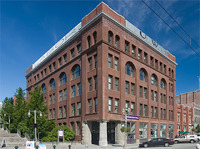What’s the coolest university in America? By one significant measure, it’s the University of Washington.
“Sierra Magazine,” the official publication of the Sierra Club, has named the University of Washington as the top university in the country for its initiatives to operate sustainably and limit its contributions to global warming. The rating is for the UW’s three campuses in Seattle, Bothell and Tacoma.
This is the fourth year the UW has been among the top-ranked schools; it was fourth last year. The complete list of “cool schools” is available at http://www.sierraclub.org/coolschools . Schools were ranked on 10 factors: efficiency, energy, food, academics, purchasing, transportation, waste management, administration, financial investments and other initiatives.
“We take great pride in the leadership the university has shown in reducing our impact on the environment and operating as sustainably as we know how,” said UW President Michael Young. “Many students, faculty, and staff have worked tremendously hard over the years to accomplish these goals, and it is very gratifying to see their commitment and effort rewarded by this outstanding recognition from Sierra Magazine. It’s a great No. 1 position to hold.”
The university established a formal policy on environmental stewardship and has developed an ambitious Climate Action Plan, a document laying out the broad strategies the UW will use to become climate neutral. In addition, the university has committed to build all state-funded, federal stimulus-funded, and specific client goal-directed new construction and major renovation projects to at least the Silver level under Leadership in Energy and Environmental Design (LEED) standards, an internationally-recognized green building certification system.
“Placing first in sustainability for our campus is an honor,” said Lia Wetzstein, instructional supervisor andco-chairwoman of the UW Tacoma Chancellor’s Advisory Committee on Sustainability. “I feel like it’s a responsibility to be a leader in sustainability in higher education.”
At UW Tacoma, the Cherry Parkes and Mattress Factory buildings achieved LEED Silver certification, Philip Hall achieved Gold, and the Joy building is awaiting confirmation of the top rating of Platinum. In an example of the university’s use of recycled materials, the Joy building also incorporated guardrails and screens made of salvaged beams and columns.
Meanwhile, the university’s planned Hood Corridor project is being designed to meet goals in alternative transportation, energy reduction and water quality. The project, which will transform a historic rail corridor to park space, will include bike and pedestrian pathways that connect to the Prairie Line Trail through Tacoma and feature energy-efficient LED lighting. UW Tacoma is collaborating with the City of Tacoma on a system along the corridor to improve the quality of stormwater that currently flows untreated into the Foss Waterway.
On the academic front, the sustainability committee is working to create an interdisciplinary minor in sustainability.
In other efforts, UW Tacoma students maintain a composting station and “Giving Garden” to provide produce to the community; plans to install recharging stations for electric vehicles in the parking garage of the Court 17 apartment complex; plans to develop a central energy plant incorporating a low temperature loop and geothermal heat exchange to achieve campus carbon neutrality by 2030; and begins a project Monday to replace aging heat pumps and air conditioning chiller units in several buildings with energy-efficient models that use an environmentally friendly refrigerant.
In Seattle, the campus has implemented wide-ranging energy conservation projects, emphasizes local organic and natural foods in its housing and food services, and recently launched UW Zimride, asocial networking ride sharing program.
As a participant of the Pacific Northwest Smart Grid project, the Seattle campus will install meters and equipment tomeasure energy consumption at two residence halls and two academic or research buildings, and upgrade electrical building meters to smart meters in as many as 200 buildings.





